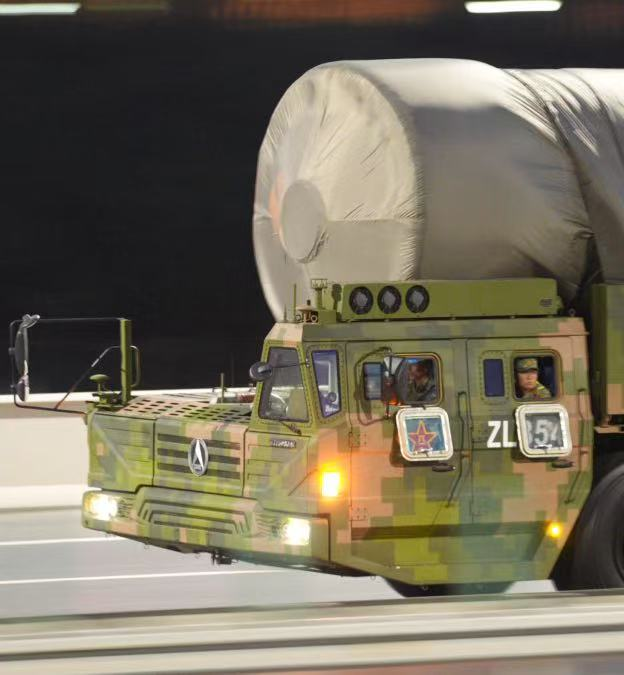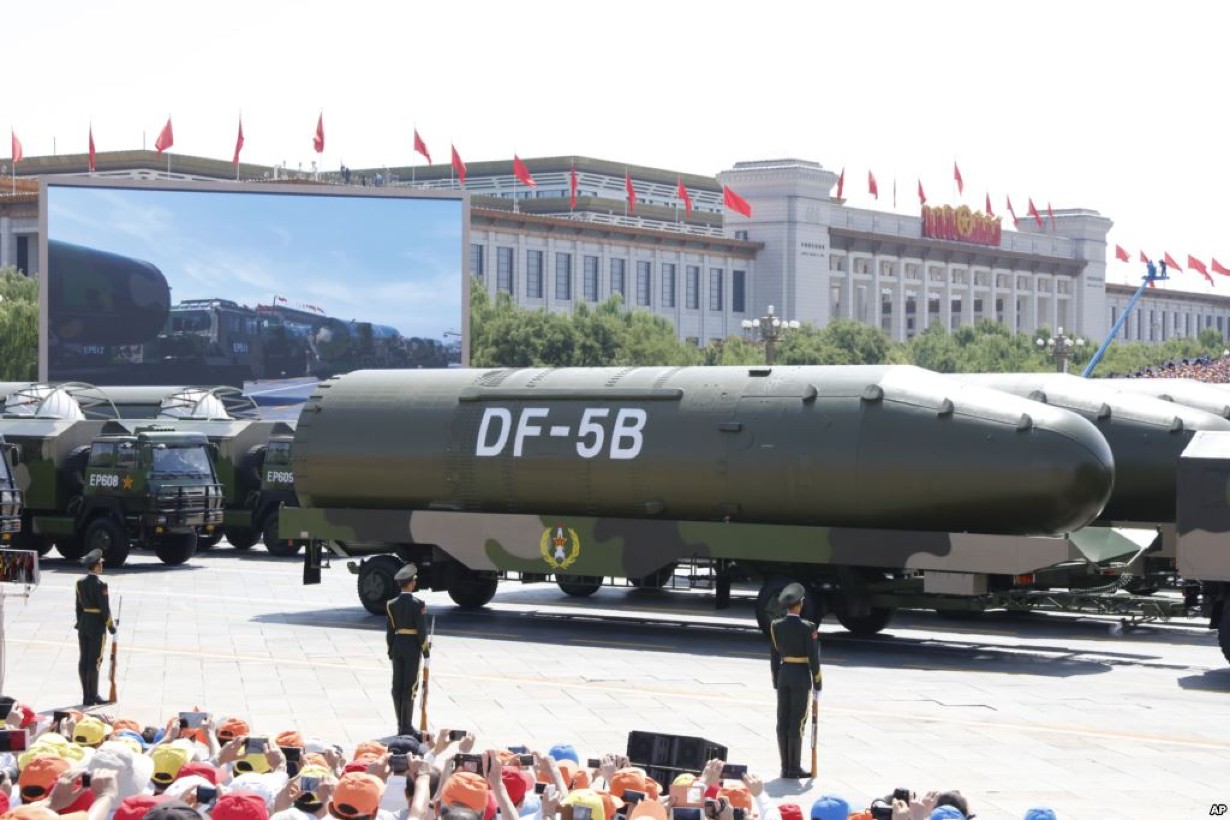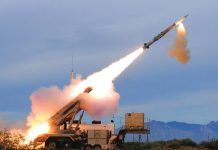A variety of brand-new military hardware has been photographed in Chinese streets as the People’s Liberation Army (PLA) prepares for the military parade marking the 80th anniversary of the end of the Second World War.
The parade, to be held on September 3, will mark the triumph of the Chinese People’s War of Resistance against Japan.
More importantly, the event would be used as an opportunity by the PLA to display cutting-edge weapons that have been developed, tested, and integrated into its formidable forces.
“In addition to displaying the new generation of traditional weapons and equipment, some new combat forces such as unmanned intelligence, underwater warfare, network and electronic attack and defense, and hypersonic warfare equipment will also be featured in the parade,” a previous Xinhua report stated.
The United States would keenly watch the latest advancements in Chinese military technology and capabilities. US military leaders have repeatedly expressed particular concern over the PLA’s advancements in naval power, aerospace technology, and integrated systems.
“They are certainly putting a lot of resources into capabilities,” said Gen. David Allvin, Chief of Staff of the US Air Force said earlier this year at a military panel. “Will they fight? I don’t want to find out. But they’ve got a leader with ambition,” he added, referring to President Xi Jinping. “That’s something we need to take very seriously.”
The concern about the unprecedented modernisation and scaling of capability is spot on, as recently demonstrated by a flurry of images showing new, previously unseen military equipment on the streets of Beijing.
What’s more alarming? China could deploy these new, unknown systems in the event of a conflict because it’s already operational.
New Weapons Are Ready For Debut
Missiles
Some noted military analysts and PLA watchers, including Rick Joe, drew attention to the YJ-series of missiles seen in photos taken by locals and initially posted to the Chinese internet. These include the YJ-15, YJ-17, YJ-19, and YJ-20.
Though the exact role of these missiles is not known at this point, all of them except YJ-15 are predicted to be hypersonic weapons (travel at five or more times the speed of sound).
The YJ-17 seems to have a unique hypersonic glide vehicle that is comparable to China’s first operational HGV missile, the DF-17.
Meanwhile, the YJ-19, seen with an air inlet, could be a scramjet hypersonic missile. Additionally, military experts predict that the YJ-20 could be a maneuverable re-entry vehicle based on its purported biconic aerodynamic design.
Hypersonic technology allows a country to fuse extreme speed, maneuverability, and low-altitude flight, making them harder to track and detect. Unlike ballistic missiles, hypersonic weapons do not follow a ballistic trajectory and can maneuver to their destination.
Various new missiles (ship UVLS launch?) confirmed, my 2c on roles:
– YJ-15, ramjet compact supersonic?
– YJ-17, waverider hypersonic glide?
– YJ-19, ?maybe scramjet hypersonic?
– YJ-20, biconical hypersonic/aeroballistic? Possibly seen before from 055..Via REautomaton, SDF pic.twitter.com/9061QDAi09
— Rick Joe (@RickJoe_PLA) August 17, 2025
China is believed to be the world leader in hypersonic technology, as acknowledged by the US Department of Defense, surpassing both the US and Russia in developing conventional and nuclear-capable hypersonic weapons.
These new missiles are in addition to the several other hypersonic weapons in the Chinese inventory, including the DF-17, air-launched YJ-21 anti-ship missile, the ground-based DF-26B, and the long-range DF-27.
The US Defense Secretary Pete Hegseth warned in April 2025 that China’s hypersonic missiles could sink all US aircraft carriers within minutes of a potential conflict.
Road-Mobile ICBM
A new or an upgraded variant of an existing road-mobile Intercontinental Ballistic Missile (ICBM) system was also recently spotted in Beijing, carried by a transport-erector-launcher vehicle with a single-side cab design, and covered by a tarp.
Though not much is known about this new system, we know that an ICBM is a ground-based missile with a range exceeding 5,500 kilometres that flies on a ballistic trajectory and is typically (but not necessarily) armed with a nuclear warhead or warheads.
The US considers the Chinese ICBMs to represent the biggest threat as they have the range to target the American mainland.

The new ICBM is potentially equipped with multiple independently targetable reentry vehicles (MIRVs) like the DF-41, according to observers. If true, it would exploit gaps in US ballistic missile defenses, which are designed primarily for less sophisticated threats.
This new system was spotted just months after China’s state broadcaster CCTV released crucial details about one of the country’s premier nuclear-capable missile systems, the DF-5, seen as a warning to its rivals.

China currently has about 400 ICBMs, and the US predicts that the number will expand to about 750 by 2035. This new ICBM aligns with China’s ongoing military modernization and expansion of its nuclear missile capabilities.
Loyal Wingman or Collaborative Combat Aircraft
One of the most significant sightings on the streets of Beijing is that of Uncrewed combat air vehicles (UCAV), believed to be a Collaborative Combat Aircraft (CCA) or loyal wingman drone.
The UCAV resembles either the Chinese FH-97 or the American YFQ-42A, as noted by popular PLA watcher Andreas Rupprecht.
The new, unnamed drones were spotted on the back of a truck during parade rehearsals. One of these resembles the FH-97 or FH-97A, which have been displayed as scale models at exhibitions since 2022. It features a thicker and shorter nose cone compared to the FH-97, with a larger internal volume, suggesting enhanced payload or sensor capacity.
Yesterday we saw a first blurry photo of one of the CCA/UCAVs, which resembles either the Chinese FH-97 or the American YFQ-42A … today we have again still blurry but at least a bit clearer photos of two more. pic.twitter.com/82N8eGnGZf
— @Rupprecht_A (@RupprechtDeino) August 17, 2025
Like the YFQ-42A, the drones are likely designed to operate as a “loyal wingman” alongside manned fighters like the J-20 and J-35A stealth fighters for roles such as air-to-air combat, electronic warfare, or munitions delivery from internal bays.
Alongside the unnamed CCA, a rotary wing unmanned aircraft was observed, possibly an intermeshing-rotor design similar to the Kaman K-MAX or CQ-24A. Experts said that its compact, foldable rotor design suggests potential for ship-based operations, with a large fuselage suitable for transport missions.
Next-Generation Armored Vehicles
The PLA’s next-generation armoured vehicles have also drawn attention.
The photos published online show a next-generation Chinese tank with four-sided radar, active protection systems, a laser weapon, and an air defense gun. This combination improves survivability against unmanned aerial vehicles, loitering munitions, rocket-propelled grenades, and anti-tank missiles, as noted by observers.
While the crew is seen wearing smartwatches and helmets with tactical augmented reality and virtual reality displays, a 105mm main gun appears to be mounted atop an autonomous turret, indicating that the tanks employ a mix of unmanned and human technologies.
Medium_Tank
ZTZ-201 & derivative infantry fighting vehicles (IFV) .the Chinese Army's new fourth-generation Medium Main Battle Tank.➡️40-tonne class.
➡️New, next-generation 105 mm main gun.
➡️Remotely controlled turret, three-person crew compartment at the front of the hull.… pic.twitter.com/0zOTQk25Tq— 笑脸男人 (@lfx160219) August 17, 2025
More importantly, though, new airborne IFVs and APCs were seen, tailored for airborne deployment. These vehicles are compact, likely equipped with a 30mm cannon, and designed for rapid deployment with the PLA’s airborne forces.
“Fairly well equipped in technology,” Rick Joe quipped on X.
In addition, new IFVs and fire support vehicles were spotted, featuring active protection systems similar to those on the light tank. These vehicles are designed to complement the PLA’s networked battlefield capabilities, with enhanced protection and modularity. These are intended for troop transport, fire support, and potentially command-and-control roles, with APS to counter modern threats like drones and precision munitions.
Directed Energy Weapons
A large, boxy eight-wheeled vehicle with a covered turret, bearing an “HZ” designation, was identified as a potential naval laser air defense system. Its size suggests it can support a directed-energy laser capable of countering anti-tank missiles, drones, and other threats.
Unmanned Underwater Vehicles (UUVs)
Two new extra-large unmanned underwater vehicles were spotted on trailers: the AJX002 and a larger one that remains under wraps, as noted by the South China Morning Post.
Propelled by pump jets, the torpedo-shaped AJX002 is approximately 18 to 20 meters (59 to 65 feet) long. Several military watchers said that it appeared to be similar to the Russian Poseidon, but there is no information on whether it is nuclear-armed or nuclear-powered.

The second type of XLUUV was covered by a tarpaulin, making its designation and specific features unclear. It is roughly the same length as the AJX-002 but approximately twice the diameter, with at least two sets of masts near the stern and ‘X’-form rudders.
The presence of these XLUUVs in Beijing’s parade rehearsal underscores China’s intent to showcase its advancements in autonomous undersea warfare. China has the world’s largest XLUUV program, with at least five types tested in recent years at naval bases like Sanya, Yulin, and Dalian.
Earlier systems include the smaller HSU-001 (unveiled in 2019 for reconnaissance and sabotage) and research vessels like the Blue Whale. The AJX-002 and its larger counterpart represent a leap in scale and capability.
Tilt Rotor Craft Takes Flight
In addition to all of the above, a Chinese tilt-rotor prototype performed its maiden flight, as shown in images surfaced on the country’s social media. PLAN watcher Alex Luck wrote on X that at least two prototypes are already in production.
The aircraft bears strong conceptual similarities to the American V-280 Valor and may be an answer to that American capability.
Like the US design, the rotors and drive shafts tilt to switch between vertical and horizontal flight, but the engines stay stationary. In the case of an engine failure, the prototype’s driveshaft-through straight wing enables both rotors to be driven by a single engine.
The goal of this design is to preserve flight stability and improve safety. Retractable landing gear and a T-tail layout are two more obvious features.
Another surprise … apparently a tilt-rotor prototype performed its maiden flight.
(Image via @Captain小潇 from Weibo) pic.twitter.com/mkT0PNESxG
— @Rupprecht_A (@RupprechtDeino) August 18, 2025
The design of the tiltrotor highlights Beijing’s desire to combine the speed and range of fixed-wing aircraft with the vertical takeoff and landing capabilities of helicopters.
According to analysts, these systems might give the PLA new choices for marine operations, quick transportation, and long-range attacks.
This is not to be confused with the weapons that are already in service and ready for debut at the upcoming parade. But it is safe to say that China’s rivals will be forced to sit up and take notice.
- Contact the author at sakshi.tiwari9555 (at) gmail.com
- Follow EurAsian Times on Google News




